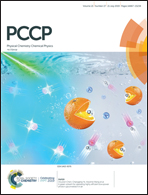A molecular contact theory for simulating polarization: application to dielectric constant prediction†
Abstract
Microscopic polarization in liquids, which is challenging to account for intuitively and quantitatively, can impact the behavior of liquids in numerous ways and thus is ubiquitous in a broad range of domains and applications. To overcome this challenge, in this work, a molecular contact theory was proposed as a proxy to simulate microscopic polarization in liquids. In particular, molecular surfaces from implicit solvation models were used to predict both the dipole moment of individual molecules and mutual orientations arising from contacts between molecules. Then, the calculated dipole moments and orientations were combined in an analytical coupling, which allowed for the prediction of effective (polarized) dipole moments for all distinct species in the liquid. As a proof-of-concept, the model focused on predicting the dielectric constant and was tested on 420 pure liquids, 269 binary organic mixtures (3792 individual compositions) and 46 aqueous mixtures (704 individual compositions). The model proved to be flexible enough to reach an unprecedented satisfactory mean relative error of about 16–22% and a classification accuracy of 84–90% within four meaningful classes of weak, low average, high average and strong dielectric constants. The method also proved to be computationally very efficient, with calculation times ranging from a few seconds to about ten minutes on a personal computer with a single CPU. This success demonstrates that much of the microscopic polarization concept can be satisfactorily described based on a simple molecular contact theory. Moreover, the new model for dielectric constants provides a useful alternative to computationally expensive molecular dynamics simulations for large scale virtual screenings in chemical engineering and material sciences.



 Please wait while we load your content...
Please wait while we load your content...